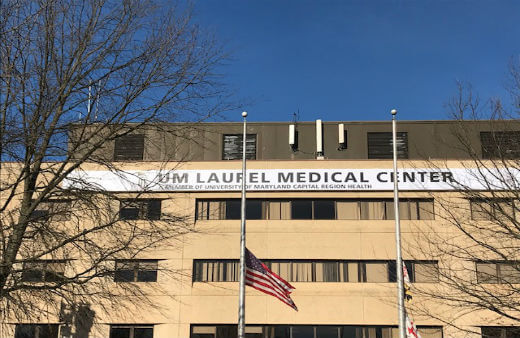As State Reopens Laurel Hospital, Medical Execs Call Flexibility to Move Patients Key to Treatment

The reopening of the Laurel Regional Hospital will expand the number of treatment beds available to the residents of the Maryland county hardest hit by the COVID-19 pandemic, Gov. Lawrence J. Hogan Jr. (R) and Prince George’s County Executive Angela D. Alsobrooks (D) said on Wednesday.
The facility has 135 beds to treat coronavirus patients, including 35 ICU beds.
Speaking to reporters outside the facility, Hogan said that when he launched a hospital surge plan in mid-March — with the goal of adding 6,000 beds — he urged his team to look at Laurel.
“The very first suggestion I had in our very first meeting discussing this topic, with our team that first day, was why don’t we reopen the Laurel hospital?” said Hogan, whose father served as Prince George’s County executive in the late 1970s and early 1980s.
“With its rebirth, it is once again going to help us save lives, not just here in Prince George’s County but throughout the national capital region.”
Hogan said the “renovated and reconfigured” facility, which shuttered in 2015, will be staffed by nearly 400 contract workers through the University of Maryland Medical System. It had a “soft opening” on Monday, according to hospital officials, to give staff the chance to get acclimated.
“We’re re-opening floors three, four and five here at the Laurel hospital, which will lessen the stress on many of our existing medical facilities,” Alsobrooks told reporters.
“We know that we are still very much in the middle of this, and that we will have great need in the coming weeks to be able to care for Prince Georgians in Prince George’s County,” she added.
According to Jania Matthews, a spokeswoman for the University of Maryland Capital Regional Health, patients currently at the UM Laurel Medical Center’s COVID-19 units were transferred from within UM Capital Region Health, which includes the UM Bowie Health Center, UM Prince George’s Hospital Center and UM Laurel Medical Center.
Executives from two large hospital systems told the Joint COVID-19 Response Legislative Workgroup earlier on Wednesday that their ability to cope with the historic pandemic has relied in large part on their ability to move patients, personnel, equipment and supplies from facilities where space has grown tight to hospitals where beds are available.
When the Baltimore-Washington Medical Center in northern Anne Arundel County began to see a surge in cases last month, UMMS, which owns 13 hospitals, relocated a select group of patients, the systems’s president and CEO, Dr. Mohan Suntha, told lawmakers.
Many were moved from the Glen Burnie facility to UMMS hospitals in downtown Baltimore or Towson.
Weeks later, when the situation in Anne Arundel stabilized and Prince George’s County experienced a spike, UMMS moved patients from its Cheverly facility to the Baltimore-Washington Medical Center.
“For us as a health system, the way we’ve approached this entire challenge is to try and leverage the size and scale of our system and maintain the high quality of care as well as recognizing the challenges that come,” Suntha said.
Hogan also announced that Maryland has contracted with the Chicago-based National Opinion Research Center to conduct contact tracing of COVID-positive persons.
The governor has said that contact tracing and adequate testing capabilities are essential before he can ease restrictions on social interaction and business activity.
The heath care administrators who briefed the General Assembly backed Hogan’s insistence that hospitalization rates must decline for two weeks before reopening of the economy can be done safely.
“The number we have used is a consecutive 14-day decline in the number of hospitalizations and the numbers of ICU admissions,” said Dr. Stephen R.T. Evans, the chief medical officer of MedStar Health. “We need a sustained 14-day decline to actually talk about opening up the state.”
Evans called the state’s acquisition of kits capable of conducting half a million COVID-19 tests from South Korea a significant advance, but he said more testing will be needed over the long term.
“All of us are desperately waiting for the big commercial players to put up large, big platforms that would do rapid testing that are highly efficient and really fast,” he told lawmakers. “We’re going to need, at the state level, to have the ability to do rapid testing.”
With 27% of the state’s known cases and 24% of the confirmed deaths, Prince George’s County is the epicenter of Maryland’s coronavirus outbreak.
Alsobrooks lamented that men are dying at a higher rate than women. She said that in some cases COVID-19-infected men whose symptoms worsen are waiting too long to call for help.
“We’re very concerned that men have been waiting,” she said. “If you’re having symptoms, do not wait. We were so distressed to learn that at least a couple of our residents died at home last week because they waited too late to seek medical treatment.”
Alsobrooks said residents who cannot speak because of their illness can text 911 and emergency personnel will respond. However, texting to 911 is available in many, but not all, Maryland counties.




 Creative Commons Attribution
Creative Commons Attribution